1995 Oldsmobile Cutlass Supreme fog light
[x] Cancel search: fog lightPage 7 of 340

Vehicle Symbols
These are some of the symbols you may find on your vehicle.
3.
For example,
these sym%ols
are used on an
original battery:
POSSIBLE A
CAUTION
INJURY
PROTECT EYES BY
SHIELDING
CAUSTIC
BURNS
SPARKS
OR
FLAMES
SPARK
OR
FLAME ,I#$,
COULD
EXPLODE
BATTERY
These symbols are important
for you and
your passengers
whenever your vehicle is
driven:
POWER
WINDOW n-
These symbols
have to do with your lights:
SIGNALS e
TURN
pA;:z
pf
WARNING A
HAZARD
FLASHER
HIGH
LAMPSoR BEAM = =o
FOG LAMPS 3 0 '
These symbols
are on some
of
your controls:
WINDSHIELD
WIPER
'r' -4
WINDSHIELD 6$
WASHER I
WINDSHIELD
DEFROSTER
REAR
WINDOW
DEFOGGER
VENTILATING
b
. FAN
These symbols are used
on
warning and
indicator lights:
CHARGING ,I-1
BAllERY
SYSTEM
BRAKE
(a)
RADIATOR COOLANT
a
ENGINE OIL
PRESSURE Wh
. TEMP OIL
ANTI-LOCK
(@)
BRAKE
Here are some
other symbols
you may see:
FUSE
RADIO
k
VOLUME a
CONDITIONING AIR 43
LIGHTER k
SPEAKER
b
V
Page 100 of 340
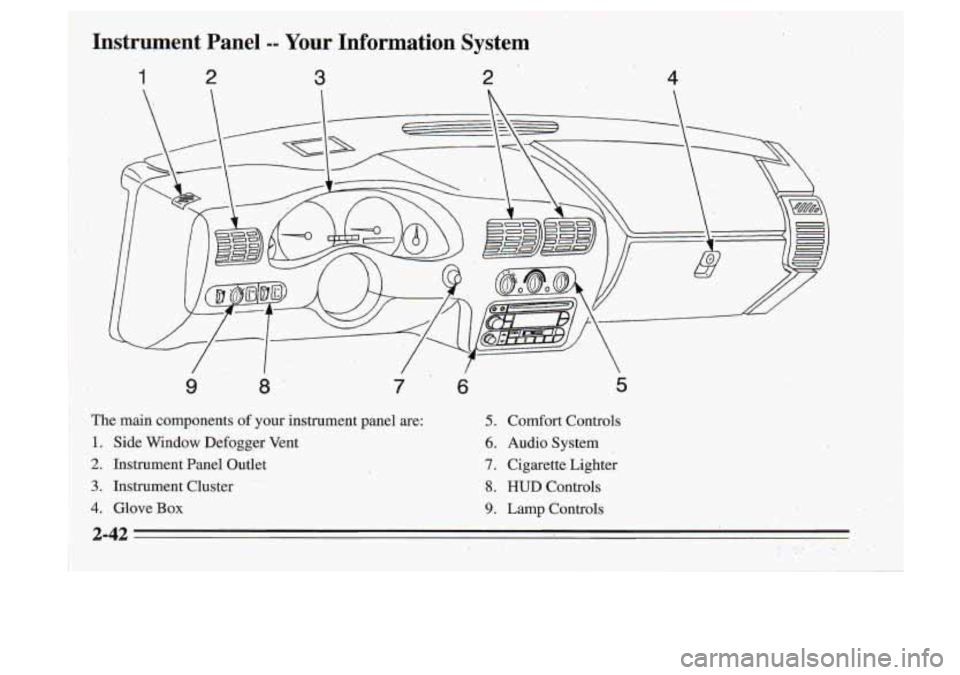
,Instrument Panel -- Your Information System
1 2 3 2
9 8’ 7 6 5
The main components of your instrument panel are: 5. comfort Controls
1. Side Window Defogger Vent 6. Audio System
2. Instrument Panel Outlet 7. Cigarette. Lighter
3. Instrument~Cluster 8. HUD Controls
4. Glove Box 9. Lamp C,ontrols
2-42 .. .’ . . , ..
Page 119 of 340
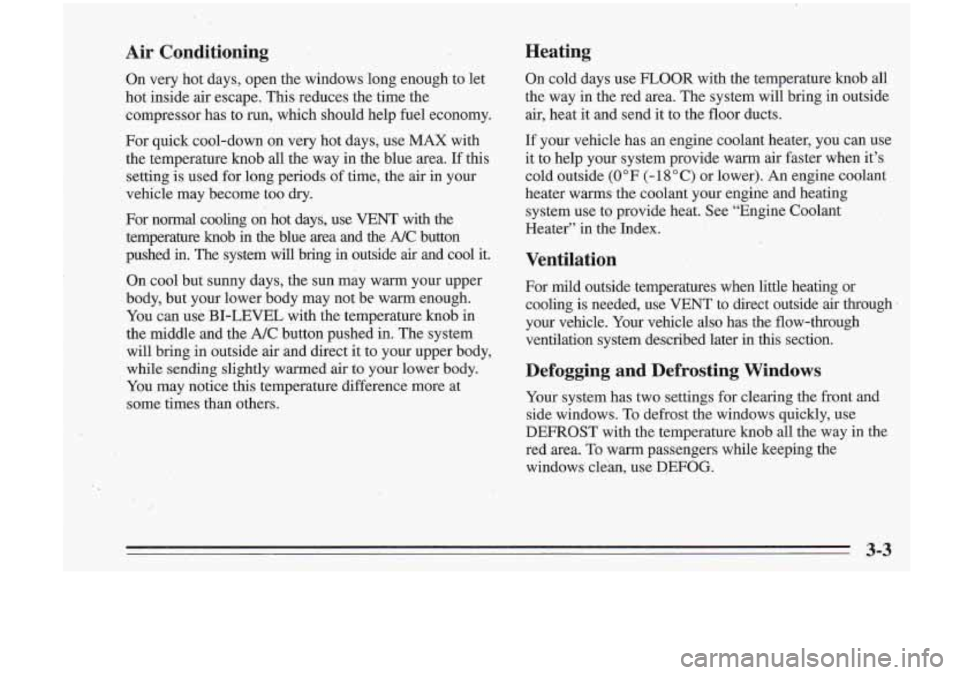
Air Conditioning
On very hot days, open the windows long enough to let
hot inside air escape. This reduces the time the
compressor has to run, which should help fuel economy.
For quick cool-down on very hot days, use
MAX with
the temperature knob all the way in the blue area. If this
setting is used. for long periods of time, the air in your
vehicle may become too dry.
For normal cooling on hot days, use
VENT with the
temperature knob
in the blue area and the NC'button
pushed
in. The system will bring in outside air and cool it.
On cool but sunny days, the sun may warm your upper
body, but your lower body may not be warm enough.
You can use BI-LEVEL with the,terhperature
knob in
the middle and the
A/C button pushed in. The system
will bring
in outside air and direct it to your upper body,
while sending slightly warmed
air to your lower body.
You may notice this temperature difference more at
. '
some times than others.
J
Heating
On cold days use FLOOR with the temperature knob all
the way
in the red area. The system will bring in outside
air, heat it and send it to the floor ducts.
If your vehicle has an engine coolant heatkr, you can use
it to help your system provide warm air faster when it's
cold outside
(0" F (-1 8 O C) or lower). An engine coolant-
heater
warms the coolant your engine and heating
system use to provide heat. See "Engine Coolant
Heater" in the Index.
Ventilation
For mild outside temperatures when little heating or
cooling is needed, use
VENT to direct outside air through
your vehicle. Your vehicle also has the flow-through
ventilation system described later in this section.
Defogging and Defrosting Windows
Your system' has two settings for clearing the front and
side windows. To defrost the windows'quickly, use
DEFROST with the temperature knob all the way in the
red area. To warrn passengers while keeping the
windows' clean, use
QEFOG.
3-3
Page 121 of 340
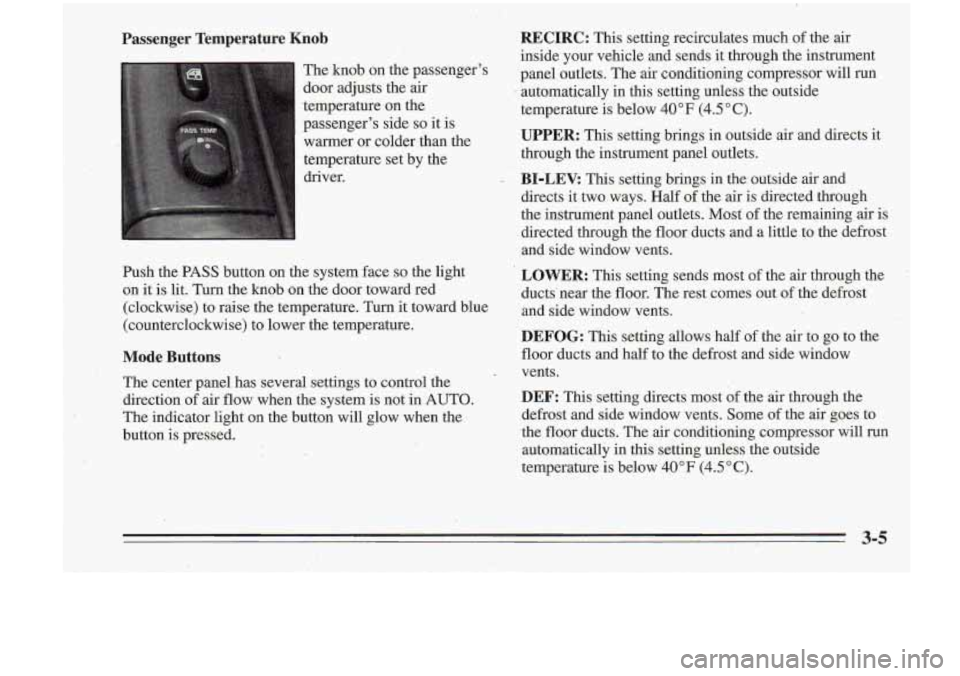
Passenger Temperature Knob
The knob on the passenger's
door adjusts the air
.temperature on the
passenger's side
so it is
warmer or colder- than -the
temperature set by the
driver.
Push the PASS button on the system face
so the light
on
it is lit. Turn the knob on the door toward red
(clockwise) to raise the temperature. Turn it toward blue
(counterclockwise) to lower the temperature.
Mode Buttons
The center panel has' several settings to control the
direction of air flow when the system is not in 'AUTO.
The indicator light on the button will glow when the
button is pressed.
RECIRC: This setting recirculates much of the air
inside your vehicle and sends it through the instrument
panel outlets. The air conditioning compressor will run
automatically
in this setting unless the outside
temperature
is below 40°F (4.5"C).
UPPER: This setting brings in outside air and directs it
through the instrument panel outlets.
BI-LEV. This setting brings in the outside air and
directs it two-ways. Half of the air is directed through
the instrument panel outlets.
Most of the remaining air is
directed through the floor ducts and a little to the defrost
and side window vents.
LOWER: This setting sends most of the air through the
ducts' near the floor. The rest comes out of the defrost
and side window vents.
DEFOG: This setting allows half of the air to go to the
floor ducts and half to the defrost and side window
vents.
DEF: This setting directs most of the air through the
defrost and side window vents. Some of the air goes
to
the floor ducts. The air conditioning compressor will run
automatically in this setting unless the outside
temperature is below
40°F (4.5"C).
Page 122 of 340

Automatic Control
For the most efficient operation, you ,should.set the
system temperature and press the knob. The system will
select the best fan speed and air flow, settings to keep
you comfortable. The air conditioning compressor will
run
if the outside temperature is above 40°F (4.5 ” C).
YOU may notice
a delay of three to four minutes before
the fan comes on.
Manual Control
If you prefer to manually control the heating, cooling
and ventilation
in your vehicle, push UPPER, BI-LEV,
LOWER, DEFOG or
DEE AUTO will go off the
display. Set the system to the temperature and fan
speed you want. The system will try to maintain the
temperature you set using the mode you select. The
following suggestions will help the system run more
efficiently in manual mode.
Air Conditioning
On very hot days, open the windows long enough to
let hot inside
air escape. This reduces the time the
compressor has to run, which should help fuel economy.
For quick cool-down on very hot days, use RECIRC. If
this setting is used for long periods
of time, the air in
your vehicle may become too dry. For normal cooling on hot days, use UPPER with the
A/C button pushed
in. The system will.bring in outside
air and cool it.
On
cool but .sunny days, the sun may warm your upper ,
body, but your lower body may not be warm enough. You
can use BI-LEV with the A/C’ button pushed in.’
The system will bring in outside air and direct it to your
upper body, while sending slightly warmed air to your
lower body. You may notice this temperature difference
more at some times than.others.
Heating
On cold days use LOWER. The system will bring in
outside air, heat it and send it to the floor ducts.
If your vehicle has an engine coolant heater, you, can use
it to help your system provide warm air faster when it’s
cold outside
(0°F (-18°C) or lower). An engine coolant
heater warms the‘coolant your engine and heating
system use to provide heat. See “Engine Coolant
Heater” in the Index.
Ventilation
For mild outside temperatures when little heating or
cooling is needed, use-UPPER to direct outside air through
your vehicle.
Your vehicle also has the flow-through
ventilation system described later in
this section.
3-6
-
Page 263 of 340
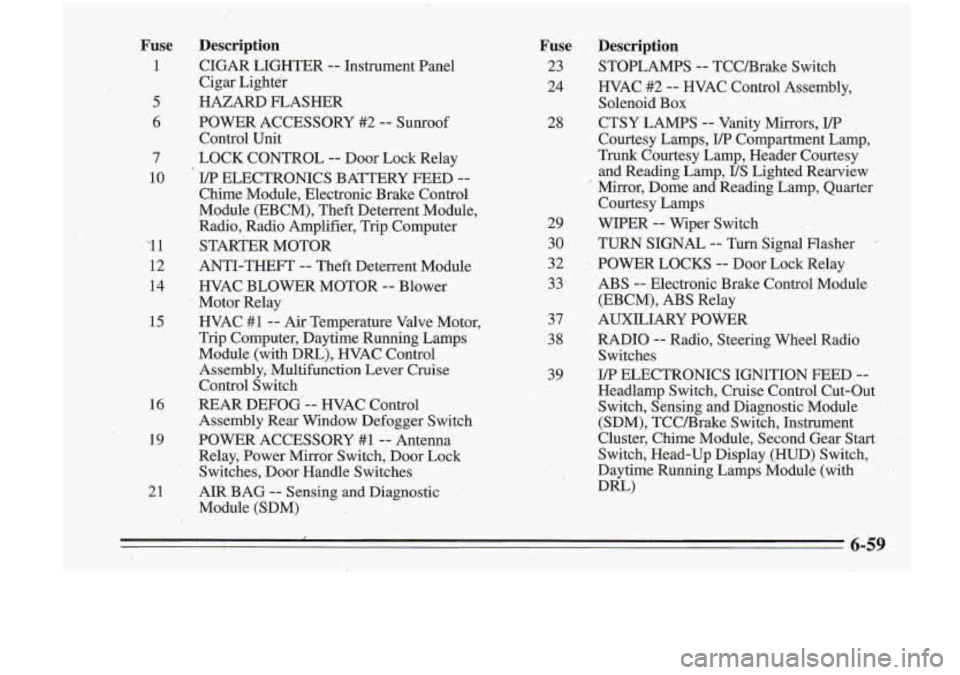
Fuse Description
1 CIGAR LIGHTER -- Instrument Panel
Cigar Lighter
5 HAZARD FLASHER
6 POWER ACCESSORY #2 -- Sunroof
Control Unit
7 LOCK CONTROL
-- Door Lock Relay
10
I/P ELECTRONICS BATTERY FEED --
Chime Module, Electronic Brake Control
Module (EBCM), Theft Deterrent Module,
Radio, Radio Amplifier, Trip Computer
'1 1 STARTER MOTOR
12 ANTI-THEFT -- Theft Deterrent Module
14 HVAC BLOWER-MOTOR -- Blower
Motor Relay
15 HVAC #1 -- Ai-r Temperature Valve Motor,
Trip Computer, Daytime Running Lamps
Module (with Dm), WAC Control
Assembly, Multifunction Lever Cruise
Control Switch
16 REAR DEFOG -- HVAC Control
Assembly Rear Window Defogger Switch
19 POWER ACCESSORY #1-- Antenna
Relay, Power Mirror Switch, Door Lock
Switches, Door Handle Switches
Fuse Description
23 STOPLAMPS -- TCCBrake Switch
24 HVAC #2
.-- HVAC Control Assembly,
28 CTSY LAMPS
-- Vanity Mirrors, I/P
Solenoid Box
Courtesy Lamps,
I/P Compartment Lamp,
Trunk Courtesy Lamp, Header Courtesy
and Reading Lamp,
US Lighted Rearview
' Mirror, Dome and Reading Lamp, Quarter
Courtesy Lamps
29 WIPER -- Wiper Switch
30 TURN SIGNAL
-- Turn, Signal Flasher -
32 POWER LOCKS -- Door Lock-Relay
33 ABS
-- Electropic Brake Control Module
37 AUXILIARY POWER
38 RADIO
-- Radio, Steering Wheel Radio
39 ELECTRONICS IGNITION FEED
-- '
(EBCM), ABS Relay
Switches
Headlamp Switch, Cruise Control Cut-Out
Switch, Sensing and Diagnostic Module
-'
(SDM), TCCBrake Switch, Instrument
Cluster, Chime Module, Second 'Gear Start
Switch, Head-Up Display (HUD) Switch,
Daytime Running Lamps Module (with
Dm)
21 AIR BAG -- Sensing and Diagnostic
Module (SDM)
6-59
Page 330 of 340
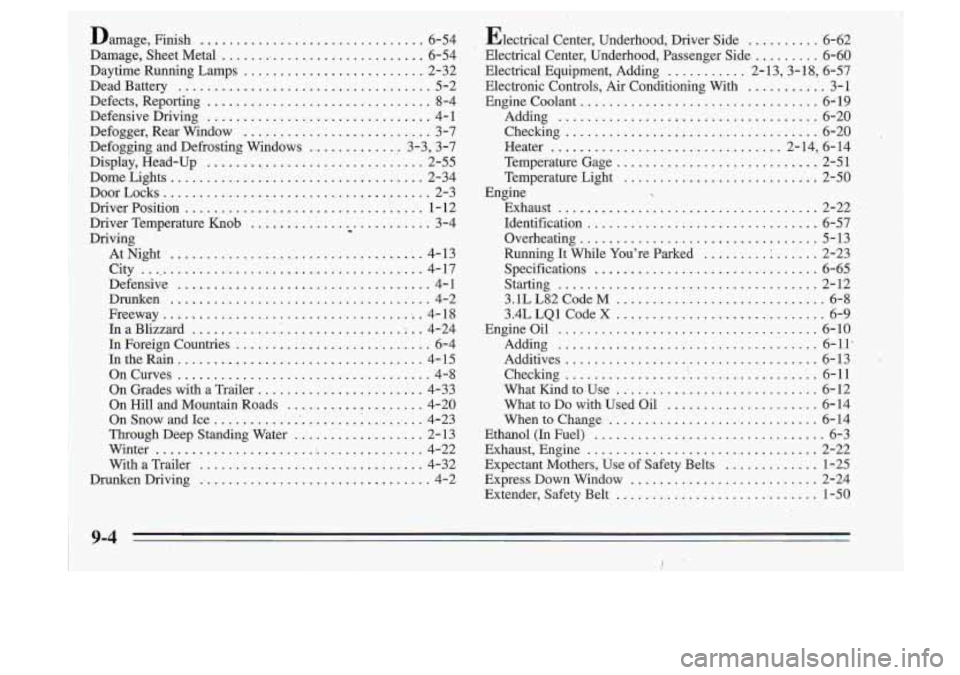
Damage. Finish ............................... 6-54
Damage. Sheet Metal ...... .- ..................... 6-54
Daytime Running Lamps .......................... 2-32
Dead Battery ................................... 5-2
Defects. Reporting ............................... 8-4
Defensive Driving
................................ 4-1
Defogger. Rear Window .......................... 3-7
Defogging and Defrosting Windows ........... i ,. 3-3. 3-7
Display. Head-Up
....... ., ...................... 2-55
Dome Lights ................................... 2-34-
DoorLocks ..................................... 2-3
Driver Position
.................................. 1-12
Driver Temperature Knob .......................... 3-4
Driving
'
AtNight ................................... 4-13
City
........................................ 4-17
Defensive
................................... 4-1
Drunken
.................................... 4-2
Freeway
........................................ 4-18
In a Blizzard
............ 1 ................ 1 .. 4-24
In Foreign Countries ........................... 6-4
IntheRain
.................................. 4-15 .
On -Curves ................................... -4-8
. On Grades with a Trailer .............. : . : ...... 4-33
On Hill and Mountain Roads
.................... 4-20
On Snow
and Ice ..................... 1 ........ 4-23
Through Deep Standing Water .................. 2-13
Winter ....................................... 4-22
With a Trailer
............................... 4-32
DrunkenDriving
................................ 4-2
9-4
Page 331 of 340
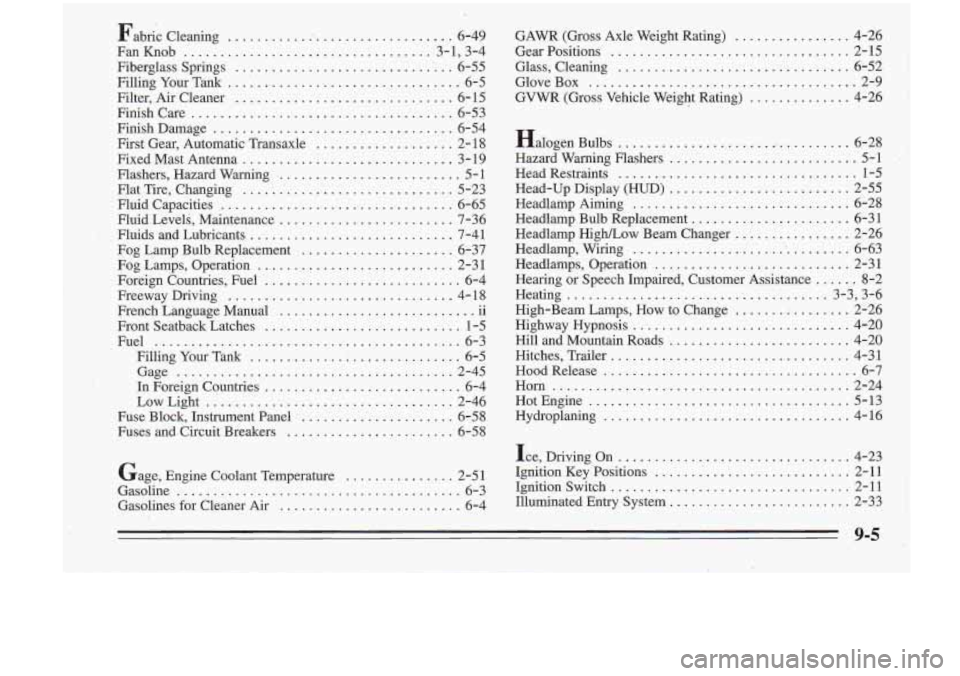
Fib& Cleaning ............................... 6-49
FanKnob
.................................. 3.1. 3.4
Fiberglass Springs
............................... 6-55
Filling Your Tank
... ............................ 6-5
Filter. Air Cleaner
.............................. 6- 15
Finishcare
.................................... 6-53
Finish Damage
................................. 6-54
First Gear. Automatic Transaxle
................... 2-18
FixedMastAntenna
............................. 3-19
Flashers. Hazard Warning
......................... 5-1
Flat Tire. Changing
............................. 5-23
Fluid Capacities
................................ 6-65
Fluid Levels. Maintenance
........................ 7-36
Fluids
and Lubricants ............................ 7-41
Fog Lamp Bulb Replacement
....................... 6-37
Fog -Lamps. Operation
........................... 2-3 1
Foreign Countries. Fuel ....... ................... 6-4
Freeway Driving
............................... 4- 18
French Language Manual
11
Front Seatback Latches ........................... 1-5
Fuel
.......................................... 6-3
Filling Your Tank
............. : ............... 6-5
Gage
...................................... 2-45
In Foreign Countries ........................... 6-4
Fuse Block, Instrument Panel
..................... 6-58
Fuses and-Circuit Breakers
................. ....... 6-58
.. ...........................
LowLight ................................... 2-46 GAWR
(Gross Axle Weight Rating)
................. 4-26
Gear Positions
................................. 2-15
Glass. Cleaning
................................ 6-52
Glove Box
...................................... 2-9
GVWR
(Gross Vehicle Weight Rating) .............. 4-26
Halogen Bulbs
................................. 6-28
Hazard Warning Flashers
.......................... 5-1 .
Head Restraints ................................. 1-3
Head-Up Display
(HUD) ......................... 2-55
Headlamp Aiming
.............................. 6-28
Headlamp Bulb Replacement
...................... 6-31
Headlamp HighLow Beam Changer
................ 2-26
Headlamp. Wiring
............................... 6-63
Headlamps. Operation
........................... 2-31
Hearing or Speech Impaired. Customer Assistance
...... 8-2
Heating
....................................... 3-3., 3-6
High-Beam Lamps. How to Change
....... .. ........ 2-26
Highway Hypnosis
............................... 4-20
Hill and Mountain Roads
......................... 4-20
Hitches, Trailer
................................. 4-31
Hood Release
................................... 6-7
Horn ......................................... 2-24
HotEngine
.................................... 5-13
Hydroplaning
.................................. 4-16
Ice. Driving On
................................ 4-23
Gasoline
....................................... 6-3 Ignition Switch 2-11
Gasolines for Cleaner
Air ......................... 6-4 Illuminated Entry System 2-33
Gage.
Engine Coolant Temperature
............... 2-51 Ignition Key Positions ........................... 2-11
.................................
.........................
9-5
'I